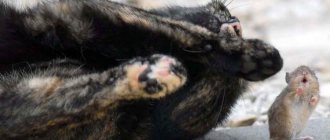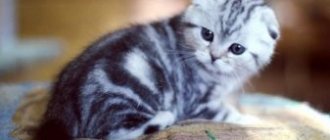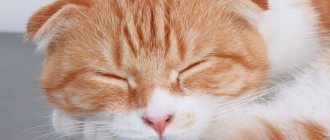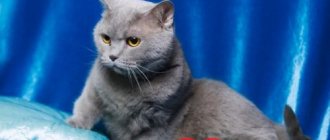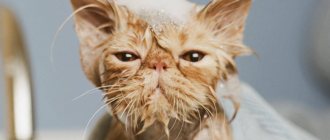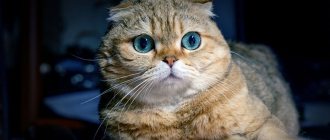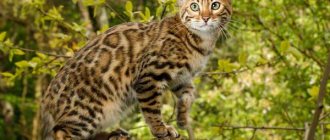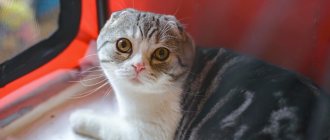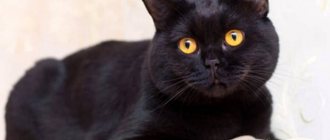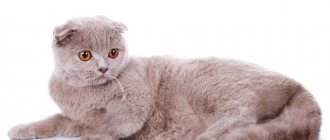- Pets
- >>
- Cat breeds
* Here is a photo of a typical representative of the Scottish Straight cat breed . You can send us photos of your animals by email, and we will post them on the website. Don't forget to send your pet's name.
Video
* We invite you to watch a video about the Scottish Straight cat . In fact, in front of you is a playlist in which you can select and watch any of 20 videos about a given cat breed by simply clicking on the button in the upper right corner of the window. In addition, the material contains quite a lot of photos. By looking at them you can find out what a Scottish Straight cat looks like.
Rate the material!
[Total votes: 6 Average: 4.5]
The Scottish Straight cat has gained enormous popularity in just half a century. These affectionate, inquisitive and good-natured cats easily get along in a variety of families. They do not require serious care and special educational methods: Scottish Straight cats are smart and easy to train.
How to choose a Scottish Straight kitten
Arm yourself with the breed standard and visit a Scottish Straight breeder in an informal setting to see with your own eyes the conditions in which the kittens grow up. Well-groomed Scottish dogs have lush, shiny coats and clear, open eyes. The abdomen of a normally developing baby is soft, and not swollen to the point of a ball. A healthy kitten's tail should be clean, and its fur should not smell bad or sparkle with bald spots.
Observe the behavior of the young Scottish Straight. A trouble-free baby willingly joins in the gameplay and shows interest. Kittens that are bored and unresponsive are most likely unhealthy or depressed. Observing the character of the babies’ parents is also a good safety net, since it is from them that the animals inherit their temperamental characteristics.
History of the origin of Scottish Straight cats
Scottish Straight cats are also called "Scottish Straight". Their history began with the development of the breed of their closest relatives - Scottish Fold cats - Scottish Folds. Scottish Folds appeared back in 1961, but their development was greatly slowed down by the fact that when crossing with representatives of the species, cats gave birth to very sick kittens with impaired musculoskeletal system.
Breeders of the breed were looking for opportunities to develop Scottish Folds, so it was experimentally discovered that Scottish cats with straight ears, when crossed with Folds, produce healthy offspring. By crossing Scottish Folds with ordinary Scottish cats, a breed of straight-eared Scottish cats was developed.
Scottish Straight are cats that, at first glance, are unremarkable. They have long, straight ears, but at the same time there is a gene for drooping ears, which does not go away after crossing. This makes the Scottish Straight ears very soft and thin. Ear cartilage is much thinner than the cartilage of ordinary straight-eared cats. But Scottish Straight kittens are born with floppy ears, so it was only possible to understand which Scottish branch was born when the kitten grew up.
Interesting fact: In 2004, the Scottish Straight cat breed was recognized in Russia and Scottish Straight cats were able to take part in championships and exhibitions. Due to its appearance and characteristic features, Scottish Straights have gained enormous popularity in the CIS countries, becoming even more widespread than in Europe. At the moment, Scottish Straight is one of the most common cat breeds.
Features of choosing a Scottish breed kitten
When choosing a kitten, the future owner is guided not only by his mind, but also by his heart. After all, this creature will live with all household members side by side for 10–15 years, and whether the pet will become a real member of the family, bring joy or become a great disappointment depends on how correct the choice is.
Before you buy a “Scottish” kitten, you need to familiarize yourself with information about this breed and study the photographs presented on the websites of nurseries with a good reputation. Purchasing an animal secondhand does not guarantee its health or purity of the breed.
Scottish kittens of any variety are born with straight ears; in future Scottish Folds, the ears fall off after 3-4 weeks.
Criteria for choosing a “Scottish” kitten
It is better to make a choice of a kitten by visiting the nursery and observing the animal in its familiar environment. First of all, it is necessary to visually evaluate the appearance of the cat you like and other babies, as well as adult animals present in the nursery. A healthy kitten has smooth, shiny fur without bald spots, clean ears and eyes. He should not sneeze, cough or itch.
A healthy kitten is an active, playful animal that is not afraid of humans.
When choosing a “Scotsman”, you must definitely pay attention to the gait - it should be free, without the discomfort experienced by the animal when walking. You should also feel the tail to see if there are any kinks on it. If any of these criteria are not met, then with a high degree of probability it can be assumed that the baby has an articular pathology characteristic of the breed.
According to the standard, Scottish Fold and Scottish Straight babies should have a rounded head, large round eyes, a short wide nose and a medium-length flexible tail.
Fold ears should be well folded and fit perfectly into the circumference of the head.
The ideal age for handing over a kitten to its owners is considered to be 2.5–3 months. It is worth refusing to purchase a pet if the breeder is ready to give the animal away before this date. Documentary support when purchasing a kitten must include a purchase and sale agreement, a veterinary passport and a pedigree.
Video: veterinarian recommendations for choosing a kitten
Scottish straight cat - description of the breed
Scottish Straight cats have a number of features that make them easy to distinguish from other cat breeds. For example, their body is quite large and massive, has a rounded shape, although the cat itself looks small and compact. At the same time, the shoulders, pelvis and paws of the Scottish Straight are very well developed, often even muscular.
The paws of the Scottish Straight are round and have a plush appearance. They are also well developed: the cat stands firmly on its feet. The paws are of medium length, and, despite their massiveness, they look graceful and slender.
The head of the Scottish Straight has a rounded, clearly distinguishable shape. The cat even has a slightly “cartoonish” appearance due to this head shape. The Scottish Straight's neck is short but strong. The paw pads are slightly more rounded than other cat breeds. Scottish Straight males are more “cheeky” than females.
The tail of the Scottish Straight can vary in length, but most often it is shorter than that of other cat breeds. Tails are strictly proportional, and a massive cat will never have a thin tail - and vice versa. The tail tapers slightly towards the end and has a characteristic rounding at the tip.
The nose of the Scottish Straight is neat and short, but not flattened, although wide. The nose has a slightly oval shape and a clearly visible base, which makes the cat's profile pronounced and graceful. This nose makes Scottish Straights look even cuter.
Cats' ears are strictly straight, with soft, elastic and slightly stretchy cartilage. Such ears emphasize the round shape of the head and make the cat’s features more expressive and bright. Scottish Straights also have beautiful, wide-open eyes, which sometimes take on a completely round shape and resemble the eyes of an owl. The color of the eyes depends on the color of the cat's fur.
Popular colors of Scottish straight cats
Scottish Straights come in a wide variety of colors, each of which is recognized by international associations and organizations specializing in the breeding of these cats. For example, white is one of the common colors for Scottish Straights. It is generally accepted that straight-eared cats have a calm, balanced character and love to be held.
There are also bright red Scottish straights. Dark or light stripes are allowed on the coat, the main thing is that the color is rich and bright. The undercoat of such a cat can be cream or beige, but white spots on the belly, paws and chest are not allowed.
The gray, silver or blue color of the Scottish Straight makes it look like a British cat. Thick blue fur looks impressive. Individuals with amber eyes and a blue tint to their fur are especially prized. All-black Scottish Straights with bright yellow eyes look similarly impressive. In this case, no spots in the color are allowed.
Also, Scottish Straights are characterized by a chocolate color. The coat must have a rich chocolate shade. White spots on the chest and paws are allowed. Interesting is the lilac color - unique among representatives of this breed. Lilac Scottish Straights have a pale beige undercoat and faint, faded red stripes.
The chinchilla color is less common. This is a noble silver color interspersed with dark gray, silver hairs on the top layer of the coat. Scottish Straights rarely have this color, so it is especially valued by cat fanciers' organizations.
In addition, there are the least common colors, such as: bicolor, merle gold, tortoiseshell.
Breed colors
Every country, and especially every nursery, works with its own favorite colors. The number of allowed options is quite large. You can choose either a single-color representative or various patterns and color marks.
Acceptable colors:
- Harlequin. On a pure white background, large markings are allowed on the back and head, the tail must be fully colored, and a different color may appear on the croup. No more than a fifth should be painted. Blue eyes are acceptable.
- Wang. Completely white except for the colored tail and a couple of spots on the head.
- Bicolor. Half of the cat is painted a different color (not white). A white closed collar is required.
- Solid white. Yellow or other shades are undesirable. Kittens are allowed to have colored spots on their heads, which should go away with age.
- Solid black. Any shade on both the coat and the undercoat (brown, ashy), as well as the presence of white hairs, is prohibited.
- Solid purple. A pinkish tint to the coat and nose is preferred.
- Solid blue. All shades are allowed, but light colors are better.
- Solid red (red). Be sure to be smooth and bright. Half rings of a light shade on the paws and a hint of a pattern on the forehead are acceptable.
- Tortoiseshell. One of the most beautiful colors. A perfect mixture of cream, red, blue, black, red and chocolate colors and shades. Preference is given to cats with a red or cream spot on their forehead. The paw pads and nose are painted in two primary colors, which predominate in the color. Kittens are allowed a smoky undercoat. Any drawings are not acceptable.
Character and habits of Scottish straight cats
The Scottish Straight cat has an affectionate, peaceful character. They easily find a common language with any people, quickly get used to the family and are willing to be held. Scottish Straights are clean and obedient animals, so they rarely make a mess or damage furniture. At the same time, they are quite playful, love to hunt and require the owner's attention.
Interesting fact: Scottish Straights are easy to train. These cats have amazing patience and restraint. They quickly learn the rules of behavior in the house, know their place well and behave in a very businesslike manner.
Cats of this breed have high intelligence. With encouragement from their beloved owner, they can even learn some tricks. In addition, cat owners claim that it is enough to calmly explain to the pet what can and cannot be done.
Scottish Straights love to sit in their arms and be close to their owner. They willingly sleep next to people, love to watch activities, and enjoy making new acquaintances. But at the same time, they cannot stand being squeezed and tormented, which is why such cats do not like children.
The Scottish Straight cat is not infinitely loyal to its owners; it is important to treat it well, otherwise the cat will not love you. Thanks to this nature, Scottish Straights quickly get used to new people, although changing their environment too often can put the cat under stress. Scottish Straights love privacy, so it is enough for them to spend a little time with their owners, which is suitable for lonely people who work a lot.
Care and maintenance
Scottish Straights are typical domestic cats for whom walks in the fresh air are pleasant entertainment, but not more than that. This is why Scots are considered ideal pets for homebodies. In everyday life, straights are unpretentious and rarely cause trouble. Take your animal for routine veterinary examinations, carry out timely vaccinations, use high-quality food - and straight-eared Scottish cats will not create any problems for you.
Hygiene
Scottish Straight loves his mistress
Scottish Straights are very clean cats that carefully monitor the condition of their own fur, but they still need to be bathed from time to time. Usually, cats are washed as their “coat” gets dirty, using shampoo from the pharmacy. At the end of the procedure, you can apply a balm to the coat. When bathing, make sure that water does not get into the animal’s ears and be sure to protect the wet pet from drafts.
Owners of show-class specimens preparing to participate in exhibitions will have to work a little harder. In particular, a few months before the event, the cat begins to be washed daily to completely remove dead cells from its skin and stimulate the growth of new fur. In addition, you will have to spend money on a variety of professional coat care products, ranging from degreasing paste to texturizing conditioner. Brush Scottish cats once a week with a short hair brush. Claws are trimmed as they grow. Be sure to monitor the condition of your cat's eyes and remove unwanted discharge with a swab soaked in hygiene lotion.
Feeding
The diet of Scottish Straights is no different from the “menu” of their fold-eared counterparts. Just like folds, Scottish straight-eared cats benefit from lean meat, offal, boiled sea fish, fermented milk products, and egg yolk. In addition, the animal’s diet should include vegetables (raw or stewed), cereals and sprouted wheat.
Prohibited
- Fat meat.
- Beans and potatoes.
- Bones.
- Sweets, spices, smoked foods.
- Garlic and onion.
- Bread.
- River fish.
- Citrus.
- Mushrooms.
- Raw eggs.
Curious Scottish Straight
In serious nurseries, Scottish Straight kittens are sold starting from the age of three months. During this period of life, the baby no longer feeds on mother's milk, which means it is able to eat the same food as an adult animal.
An important point: natural-fed straight cats do not receive enough of the vital microelements. Vitamin and mineral complexes, which can be purchased at a veterinary pharmacy, solve this problem.
Scottish Fold cats can also be fed commercial food if you are willing to spend money on its non-budget varieties - “premium”, “super premium” and “holistic”. An ideal cut for a Scottish dog should contain at least 26% protein and about 9% fat. It is advisable that the food does not contain wheat and corn, which can cause allergies in the cat. From this point of view, the most useful options for “drying” can be considered the Canadian Acana Pacifica Cat and the American Earthborn Holistic.
Three-month-old Scots are fed up to 6 times a day, six-month-old kittens eat 5 times a day, nine-month-old kittens - 4 times. One-year-old individuals are considered adults, so 2-3 meals are enough for them.
Interesting facts about Scottish Straight cats
Scottish Straight cats originate from Scotland. They always occupied a privileged position, being close to high-ranking people. These cats were valued for their beautiful appearance, proud character, royal habits and high intelligence.
2020 marks exactly 55 years since the breeding of this breed. Thanks to the Scottish Straight, the breed of fold-eared cats continued to exist, because straight-eared cats diversified the gene pool. Thus, previously weak and sickly kittens were able to be born strong and healthy.
The minimum weight allowed for Scottish Straights is 2 kg. The highest recorded weight among representatives of this breed was recorded in an adult cat, which weighed almost seven kilograms.
Scottish Straights, for the most part, are afraid of heights. Because of this psychological feature, these cats will never climb onto the closet or climb the curtains. At heights, they behave clumsily and timidly, although, if frightened, they are able to climb a tree. It will be difficult to remove the cat from there.
Scottish straights, for all their royal habits, are very inquisitive animals. They immediately show interest in new objects in the apartment and happily go to meet new people. They are interested in peering into tight corners and playing with new objects. Little kittens are especially playful and inquisitive as they are just learning about the world around them.
Scottish Straight cats are not at all aggressive. They will never rush at people and animals, but, first of all, will openly go to get acquainted. If a cat is frightened, it will not attack in response, but will prefer to hide from the offender.
Pros and cons of Scottish Straight cats
The indisputable advantages of Scottish Fold cats include the following:
- Cats are very domestic, they like to be within the familiar walls of the apartment. Despite their natural curiosity, they are not drawn to street adventures. However, if you want to take a walk with your cat, she will take it favorably. If you are nearby, the cat will feel comfortable outside;
- Scottish straights are completely devoid of aggression. During the selection process, aggressive and hyperactive kittens were rejected, thanks to which Scottish Straights acquired a peaceful, good-natured character;
- These cats are not noisy and do not have a violent temperament. Even cats during heat do not go crazy and start screaming loudly and running around the apartment. They are always affectionate and calm;
- Scottish straights become attached to all family members at once. They are favorable to all people whom they more or less trust. They allow themselves to be stroked and willingly go into the arms of all family members;
- Scottish Straights are very easy to train and train. This aspect reveals the representatives of the breed as highly intelligent animals.
The disadvantages of Scottish straights include:
- Scottish Straight cats do not like children. They don't like to be squeezed against their will, don't like to play if they don't want to, don't like twitching and loud sounds. These calm animals prefer to take the initiative in communication. Although they are not aggressive, cats will not tolerate children's games;
- Scottish straights are lazy. As soon as a cat leaves childhood, she prefers lying on the sofa with her owner or measured walks around the apartment to games. They play infrequently and only when they are in the mood;
- Although Scottish Straights love the whole family, they will also quickly become attached to strangers. If guests often come to your house, the Scottish Straight will begin to mistake them for the same owners.
Scottish cat character
global $ads_google;
//data-ad-slot=”2475549904″ $ads_google = empty($ads_google) ? false : true; ?> if ($ads_google == false) {?> $ads_google = true; ?> } ?> Since childhood, a Scottish breed kitten displays
These are kind creatures, but you should not at all correlate external plushness with character: these pussies are very capricious and can surprise with attacks of self-will. At the same time, cats do not like to show aggression and are loyal to younger family members. But this does not exclude the ability to stand up for oneself if the child wants to pull the cat by the tail.
The Scottish kitten loves to socialize, have fun with its owner, and play an active game with a person. Even a grown-up cat will not play dirty tricks behind the owner’s back. In any case, if an animal is guilty of something, it will not pretend that it is not its fault.
Touchiness and vindictiveness are also not among the characteristic traits of the breed.
Despite his ability to get along with other animals, a jealous Scot will try with all his might to take first place in the house and, most importantly, in the heart of the owner.
Breeding Scottish Straight cats
Cats reach sexual maturity at ten months, but mating should never begin at this age. The cat has not yet grown physically, and pregnancy at an early age will be a huge stress for her. There is a high probability that the animal will not even survive the birth. Therefore, Scottish Straight cats are bred only after at least two or three heats have passed.
Males are ready to mate when they reach sexual maturity - at about ten months. It is better to start breeding cats in the spring, since that is when the offspring are numerous and healthy. You can determine that a cat is ready for mating by its behavior: the Scottish Straight becomes energetic and even aggressive.
Scottish Straights can only be bred with their relatives - Scottish Folds or with representatives of their own breed. Such crossings allow you to breed cats with good health and surprisingly expressive appearance. Mating with other breeds, especially British cats, is strictly prohibited - this is fraught with serious pathologies and chronic diseases of the kittens.
Aspects that you should pay attention to when breeding Scottish Straights:
- The cat and cat must be vaccinated and must not have any parasites. All vaccinations are noted in the cats' documents;
- The cat should come into the cat's territory, and not vice versa. You should take her tray and her usual food with you so that the cat does not get nervous;
- Sometimes cats can meet their mating partner aggressively. Cats need to be given time to get used to each other.
Which cat is suitable for catching rodents?
The first conclusions about the adaptability of animals to hunting can be drawn from their behavior in childhood. If the baby is active, shows persistence in games, moves a lot, runs and is not afraid to jump - this indicates good health. Such a cat, when he grows up, can easily catch a mouse. Later, the pet demonstrates tracking and stalking skills. He freezes in the shelter, squats springily, shows signs of excitement - he moves his ears, raises the fur on his spine, hits the surface with his tail, and quickly attacks. This indicates that the Scottish Fold cat will catch mice. If, by the time the animal reaches the age of puberty, it has not acquired the listed skills, its hunting qualities will no longer appear.
The Scottish cat is an excellent choice for keeping within a private home. Most likely, she will catch mice, but not as skillfully as an ordinary yard cat does. For her, this is entertainment, not hunting. Therefore, cat prey often ends up at the feet of the owner - this is how the pet demonstrates its devotion to the person.
Caring for Scottish Straight Cats
Scottish Straight cats do not require serious care like, for example, Sphynx or Persian cats. The minimum hygiene procedure is combing the coat, which should be done two to three times a week. When shedding cats should be brushed every day. This will prevent the fur from getting tangled, and the pet will not lick off the fallen fur.
Scottish Straights can also be given a special paste that promotes the rapid release of hair from the body. There is no need to wash Scottish Straights often - about once a month will be enough. Cats are good at cleaning themselves.
Important fact: It is necessary to keep the Scottish Straight ears clean. They can be cleaned once a week with cotton swabs and lubricated with a special ointment. The eyes should also be clean and healthy, without tear discharge. If there is discharge, you need to take the cat to the veterinarian.
Scottish Straights have their nails trimmed, but only the transparent part needs to be cut off. To trim claws, you should only use a special nail clipper, which will not damage the structure of the Scottish Straight claw. After cutting, it is best to treat your cat's claws with hydrogen peroxide. It is worth trimming no more than once a week - it is best to observe when the claws stop retracting into the pads of the fingers.
The Scottish Straight cat needs regular examination by veterinarians, who will examine the general condition of the animal and the condition of its teeth. It is necessary to have regular vaccinations, which will be recorded in the cat's passport. Once every six months, cats are treated for parasites.
It is worth remembering that cats of this breed are big sleepyheads, so make sure that the cat has a comfortable bed or house. There the cat must feel safe, otherwise the animal risks getting sleep deprivation and, therefore, stress.
Health and care
On average, representatives of the breed have a good life expectancy and good health. But, as with everything, there are exceptions. Most often, problems arise with folds. In this regard, straights have healthier genes.
In terms of care, Scottish cats are also not very whimsical. They calmly get used to regular brushing. The coat, despite its softness, does not require daily combing, even for long-haired specimens.
Like any cat, the Scotsman must undergo hygiene procedures (teeth, eyes, ears). The latter, in light of physiological characteristics, is a prerequisite.
Diet of Scottish straight cats
Scottish Straight cats, like other purebred cats, can be fed with both specialized food and natural food. You should not mix feeding methods, nor should you mix different types of dry food.
Adult cats are fed twice a day. The serving volume is calculated depending on the size of the cat. A healthy cat's diet should be based on lean meats such as beef and chicken. The meat can be boiled a little or given raw.
Cats do not digest milk, so giving it is pointless. For nutritional value and as a vitamin supplement, you can cook porridge from rice, buckwheat, millet, to which pieces of meat or fish are added.
Scottish Straights need a lot of vitamins, which they can get from fresh greens. In the summer, it is enough to walk your pet so that it eats green grass, and in the cold season you can grow greens, which are sold in pet stores. The herb promotes the absorption of food and its digestion.
Interesting fact: Some cats really love bread - you can give it, but not overuse it. Scottish Straights should not be given anything salty, fried, smoked or sweet, as well as foods that are generously sprinkled with spices. Potatoes, mayonnaise and any canned food are also prohibited for Scottish Straights.
If you choose to feed with special ready-made mixtures, then you should opt for premium food. They maintain a balance of minerals, vitamins and useful things that an adult animal needs.
Diseases and health problems
Scottish Straights often suffer from watery eyes, so you should pay special attention to the health of these cats' eyes. This is due to the special structure of the skull, in which the lacrimal glands of these cats are greatly narrowed. You need to be wary if your eyes have yellow or purulent discharge. Sometimes wet eyes are evidence of reduced immunity.
The ears are also a vulnerable area for Scottish Straights. If your Scottish Straight often shakes its ears, scratches them, or becomes irritated at the slightest touch to its ears, then you should take the animal to the veterinarian. The cat probably acquired otitis media, ear mites or fungal diseases. Sometimes this happens due to the accumulation of earwax.
Osteochondrodysplasia is typical for this breed, although Scottish Folds are more often affected. With this disease, cats limp and walk on bent legs. Leg deformities occur slowly, gradually making running and jumping more difficult.
Interesting fact: Scottish Straights are prone to hair loss, but this is more common in pregnant and lactating cats. As a rule, baldness is prevented by vitamins.
Urolithiasis is also typical for the breed - it usually affects neutered adult cats or overweight animals. The problem is solved by changing the food, since often it is simply not of sufficient quality. Sometimes veterinarians recommend giving cats vitamin A. Urolithiasis can be caused by infection or hormonal imbalance. There is blood in the urine of animals suffering from this disease.
Scottish Straights are prone to obesity. The cat's ribs should be palpable, but if only fat is felt, then the cat has weight problems. It is worth controlling the amount of food your animal eats.
